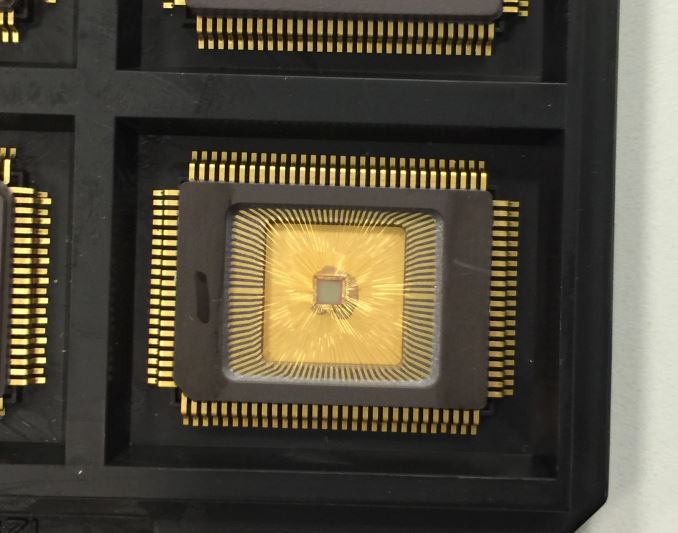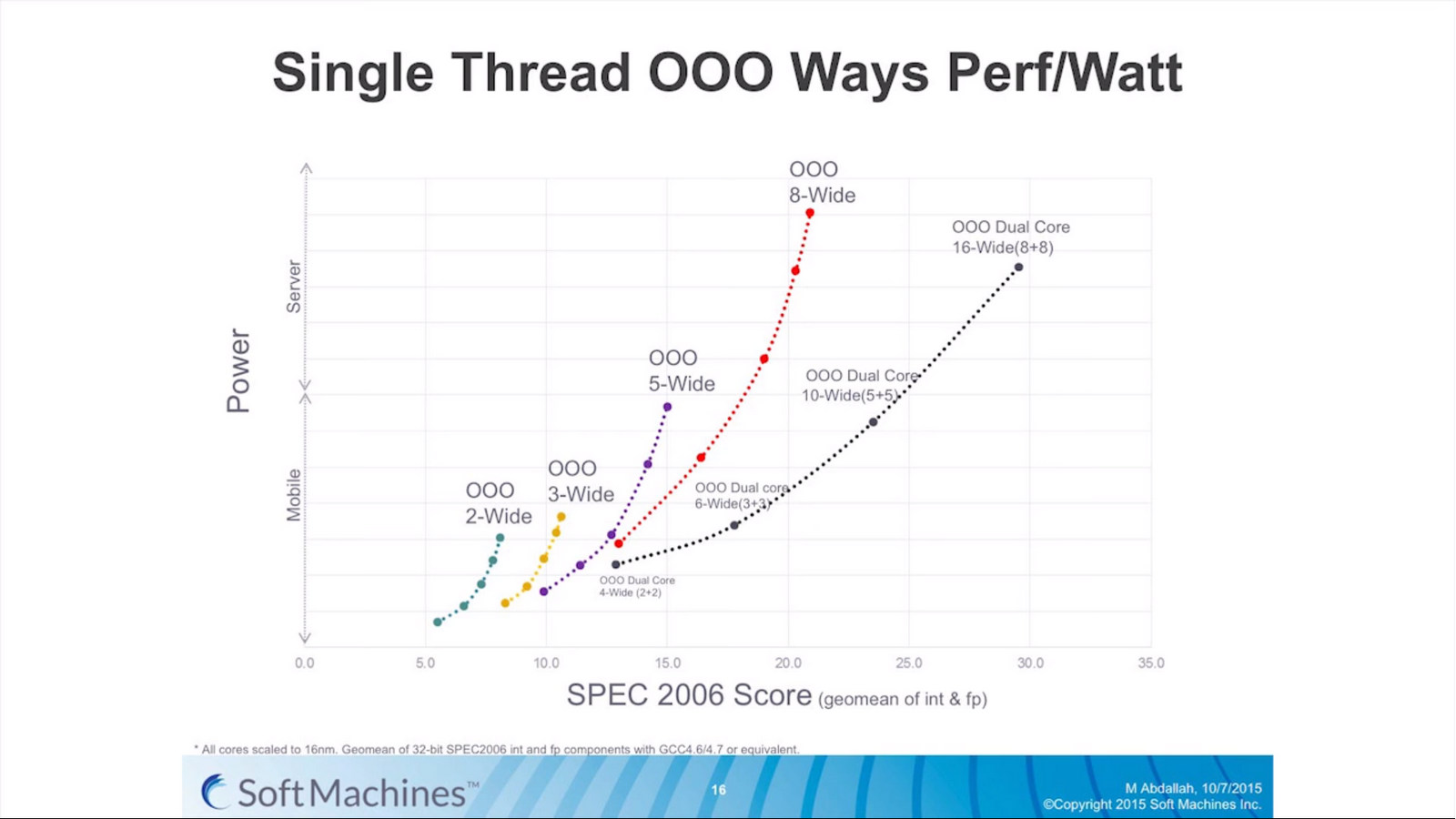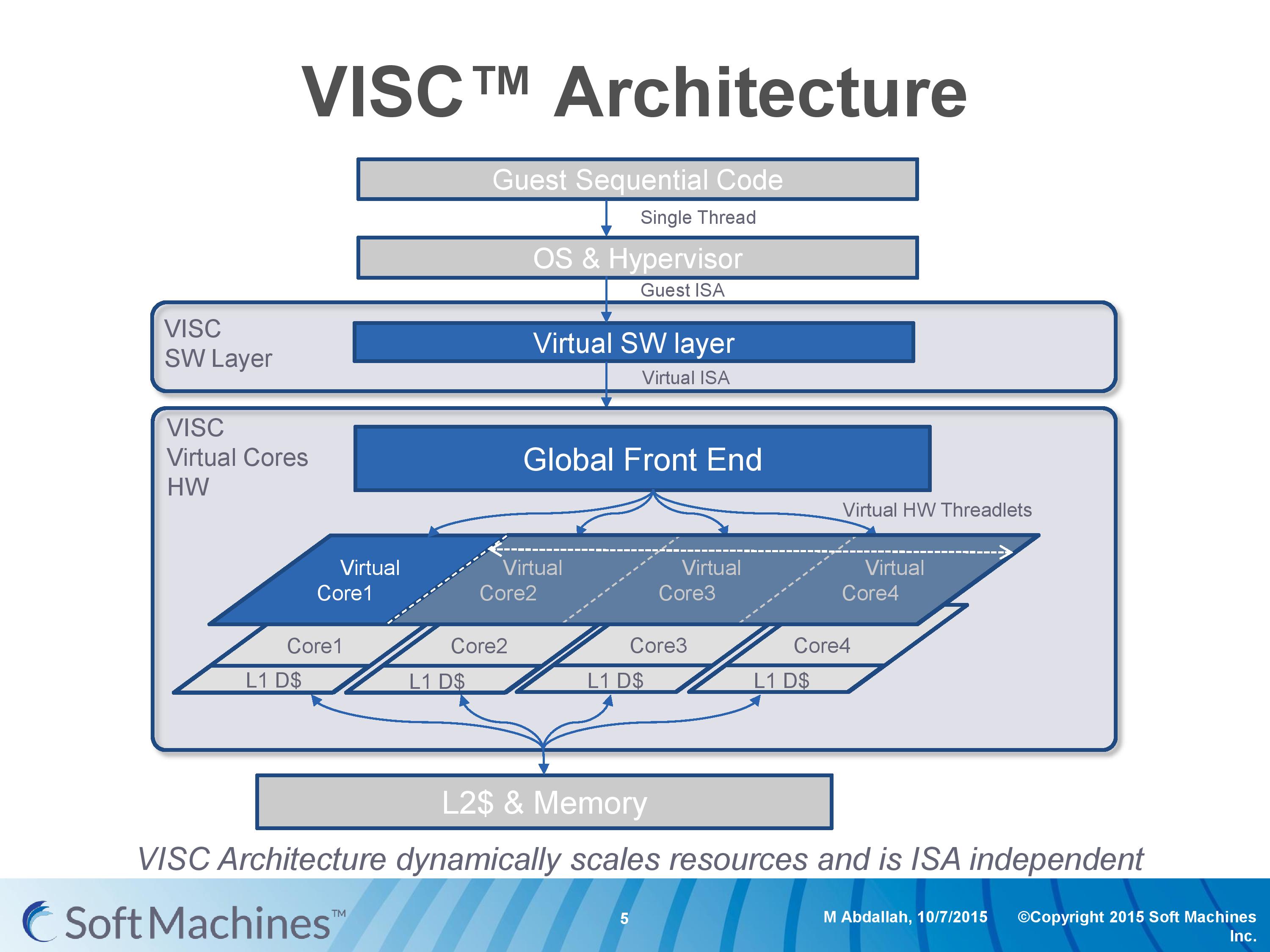Examining Soft Machines' Architecture: An Element of VISC to Improving IPC
by Ian Cutress on February 12, 2016 8:00 AM EST- Posted in
- CPUs
- Arm
- x86
- Architecture
- Soft Machines
- IPC

Last week, Soft Machines announced that their 'VISC' architecture was available for licensing, following the announcement of the original concepts over a year ago. VISC, in a nutshell, is designed as a solution to improving the number of instructions per clock a single thread can process in a given time, which potentially makes it a very interesting design in an era where IPC gains are harder and harder to realize.
The concepts behind their new ‘VISC’ architecture, which splits the workload of a single linear thread across multiple cores, are intriguing and exciting. But as with any new fundamental change in computer processing, subject to a large barrage of questions. We were invited to a presentation and call with the President and Chief Technical Officer Mohammed Abdallah and the VP Marketing and Business Mark Casey, and I put a number of questions on the lips of analysts to them.
Identifying Single Thread Performance Bottlenecks
Any discussion about processor performance over the last couple of decades has involved several factors, including getting better performance through an increased power budget, a higher frequency, extracting instruction level parallelism (ILP), getting better at minimizing delays through better branch prediction, or adding more cores and improving thread level parallelism (TLP). Each of these methods have varying degrees of success at increasing performance – long-time readers will remember the Pentium 4 days of hitting a frequency and power wall which then switched the focus to efficiency. Some tasks, like graphics, are inherently parallel and can take advantage of multiple hundreds or thousands of cores, or the software can be optimized. However, the nature of most software code and instructions is that they are single threaded by nature, and their performance relies on how fast the instructions can be processed within a single thread.
The main way of increasing performance, or in this case the instructions per unit frequency (instructions per clock, or IPC), is to expand the CPU architecture to allow more commands to be processed at once. Moving from a 3-wide out-of-order architecture to a 5-wide out-of-order architecture theoretically allows for a 66% increase in instruction throughput if (and only if) the code is sufficiently dense enough to extract those operations, and the other features in the architecture can ensure all the operations are fed every clock cycle.
The problem with moving to a wider architecture is typically power and design complexity. As shown by various chip designs over the years, the wider the architecture the more silicon has to be set aside for assets like buffers, re-order windows and caching. If there is a silicon budget and enough power headroom, we see designs like the six-wide Intel Skylake cores or the seven wide NVIDIA Denver cores able to extract peak performance when code is written that matches the hardware. However the potential downside of a wide architecture is that it remains inefficient for sets of instructions that only need a 2-wide or a 3-wide architecture. Alternatively, if multiple programs or threads want to use the hardware, then a single core is inaccessible to additional threads while the first thread is still in use (though this can be avoided somewhat by simultaneous multithreading or SMT which will let another thread have access when the first has encountered a stall such as waiting for L1/L2 memory).
As a result, modern designs also include a number of cores to handle the multile thread/multiple program scenario. Generally speaking this works well, especially with high-performance cores, but it becomes a bit of an issue itself when much of the world’s hardware is actually composed of many cores that have poor single threaded performance. Older Core 2 / Conroe systems, basic Bulldozer, or ARM Cortex-A7 designs are (still) widely used and often ship with multiple cores to allow for multiple programs at once. And while they can scale up with additional threads to the number of cores they offer, if any single or lightly-threaded software needs more performance, those extra cores are not used or are only minimally beneficial overall.
This brings us to Soft Machines, whose VISC architecture aims to change this.
Meet VISC
I should start by saying that despite the similarities to other architectural names, VISC is not an acronym. I asked directly and it is merely a noun for the purposes of trademarking. People can interpret it as a ‘virtual instruction set computing’ or something similar, but the company doesn’t apply any acronym to the letters.
But a virtual instruction set is a good description here. For the most part, processor architectures were traditionally built around either CISC (complex) or RISC (reduced) instruction sets and execution models, while more modern designs (e.g. Intel Core) are increasingly a mix, or so-called ‘CRISC’ design. The difference between CISC and RISC boils down to the fact that simpler designs can be more power efficient, but complex designs can do more complicated things in fewer cycles, all the while CRISC essentially meets the two paradigms in the middle in an attempt to gain the benefits of both, though not without inheriting some of the drawbacks as well. VISC, for lack of a better description, is a RISC design using a custom instruction set over a translation layer which allows a single thread of operations to be dispatched over multiple physical cores. The base diagram looks something like this:
Here is an example of a VISC design with four physical cores. The design can handle four ‘virtual cores’ or threads as well, but what makes the VISC design different is that when the virtual core has a thread of instructions, it can use the resources of any physical core. Thus, if each physical core is a 4-wide out-of-order design, if a thread running on a virtual core can utilize the resources of all four cores essentially making a giant 16-wide design, then under VISC can do so.
This should instantly throw up a number of questions on ‘What!? How?! Why?! Power? Frequency? Performance? Efficiency? Complexity?’ and as well as many others in the industry, we had the same questions.












97 Comments
View All Comments
xdrol - Saturday, February 13, 2016 - link
I somehow fail to see why should be scheduling 2 threads to 2 cores of 4-wide pipelines - including overhead from 'in-thread' cross-core communication - should be more effective than a 2-thread 8-wide SMT core (aka Skylake - it's not 6-wide, and SMT is fine-grained, threads don't 'wait' like the article suggests)Alexvrb - Saturday, February 13, 2016 - link
Right! It's like getting the best of narrow and wide designs at the same time. You can go wide or narrow and more/less threads as needed. It'll probably need a lot of OS support to work well. Still, the concept is interesting, and if their translation layer is fast, it could eventually handle legacy well enough.FunBunny2 - Saturday, February 13, 2016 - link
-- You can go wide or narrow and more/less threads as needed.but no known processor (or design algorithm) can create parallelism in serial code. just because a cpu wants to implement ILP to a greater extent than extant processors, it can't make parallel from nothing; it can only discover "hidden" parallel that extant processors are missing. not something I'd bet on.
Alexvrb - Sunday, February 14, 2016 - link
I was talking about the processor itself. The CPU can act like a wide or narrow design on demand. Whether or not a particular piece of code will benefit was not something I was discussing. My point is that where it helps, it can go wider than current designs. Where it doesn't help it can scale back and go narrow, leaving more cores available for other threads.In other words this doesn't displace multi-threading. A single piece of demanding software may still want to run multiple threads concurrently, to indirectly extract more parallel performance - such as a game splitting up AI, physics, audio, rendering, networking, etc into their own threads. I don't think their design eliminates the necessity of doing this sort of thing.
However they can boost average efficiency with a narrow design and lots of cores (similar to mobile ARM designs), without losing performance vs high-power designs (and in some cases gaining performance) because they can act as a wide pipeline by combining cores It's a flexible form of virtual cores that people will tend to just simplify as "reverse HyperThreading".
This is all just in theory of course, their implementation has to prove itself. Not to mention the difficulties they'll face with ISA translation, at least in the near term. If their technology takes off and gets licensed out, there will be ports of modern OS and APIs, and thus apps will be ported to run native (in the case of Windows, cloud compilation would handle the majority of RunTime apps).
Samus - Monday, February 15, 2016 - link
If the translation layer does what they say it does, that is exactly what this processor can do. It can break up serial code for parallel processing. I don't know how, or how efficient, it can do this. To analyze serial code and say ohh, so there's this complex part in the middle and the rest is simple, and send the complex part to one core and the rest to another, and somehow reassemble it after its processed, seems impossible. We have all seen promising tech flop before, Cyrix and Transmetta had some radical ideas for the way x86 worked, in the end neither could trump Intel or AMD.Alexvrb - Monday, February 15, 2016 - link
What he was saying is that some code can NOT be made parallel. They CAN take single threads and break them up, and when it's possible they can find parallel processing opportunities. But some tasks are inherently serial. Neither the programmer, nor the compiler, nor the VISC processor can make inherently serial tasks parallel. For example, if A has to happen before you can work on B.Uh, at least not with a conventional binary architecture. I don't know much about quantum processors.
easp - Friday, February 12, 2016 - link
I think uninformed pundits/press/commenters will miss the limits imposed by Amdahl's law.Its still plausible to me though that this approach will allow more efficient use of silicon and power by allowing better allocation of processor resources at runtime than is possible with traditional compilers, operating system scheduling, hardware scheduling and organization of execution resources.
Whether they can establish a viable foothold in todays competitive landscape is another issue.
Sufiyan - Saturday, February 13, 2016 - link
If anything this shows that Amdahls law is still true.Bleakwise - Tuesday, March 14, 2017 - link
They never said it violates Amdahl's law.I fact they said that 2 cores gives a speedup of 53%.
Amdahl's law says it would be a 100% speedup maximum.
Since when is 53% > 100%?
Bleakwise - Tuesday, March 14, 2017 - link
Of course, it does beg the question...Why don't we just make 24 wide CPU pipelines and allow for 3-way SMT and fatten the cores up with more units instead?